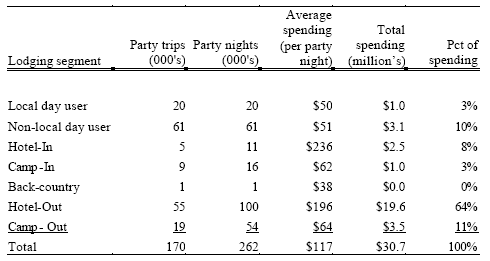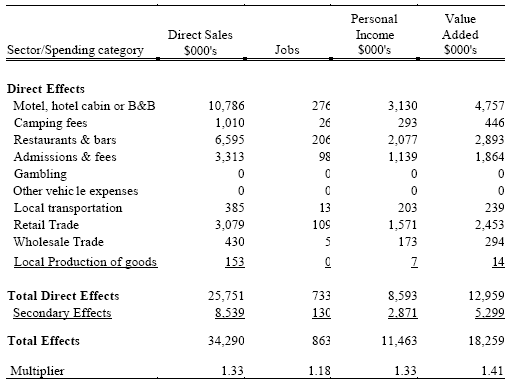Impacts of Visitor Spending on Local Economy:
Crater Lake National Park, 2001
Executive Summary
Crater Lake National Park hosted 457,000 recreation visits in 2001. Park visitors spent $30.7 million dollars in the local area (within 100 miles of the park) generating $8.6 million in direct personal income (wages and salaries) for local residents and supporting 733 jobs in the area.
Economic impacts were estimated with the updated National Park Service Money Generation Model (version 2). The MGM2 model uses park visitation data, spending averages from the 2001 Crater Lake National Park Visitor Survey and MGM2 rural area multipliers to estimate spending, income and jobs attributable to the park. In 2001, Crater Lake National Park hosted 457,000 recreation visits which equates to 170,000 party trips to the area (Table E1). The three largest segments in terms of party trips were day trips from outside the local area1 (36%), visitors staying overnight in motels outside the park (33%) and local day visitors (12%). Park visitors accounted for about 10,700 room nights at park hotels and 99,700 room nights outside the park. Campers accounted for 16,000 camping nights inside the park and 54,300 camping nights outside the park.
Table E1. Crater Lake NP visits and spending by segments, 2001
On average, park visitors spent $117 per party per day in the local area with spending varying considerably across the seven lodging segments – from $236 per night for visitors staying in park hotels to $38 dollar for backcountry campers. Visitors staying in hotels outside the park contributed 64% total park visitor spending, followed by visitors camping outside the park (11%). The majority of the visitor spending went to the lodging sector ($10.8 million), restaurants ($6.6 million) and the retail trade sector ($4.0 million).
Impacts of Visitor Spending on Local Economy: Crater Lake National Park, 2001 Page 3The sales multiplier for the region was 1.33, meaning that an additional $0.33 in sales is generated through secondary effects for every dollar of direct sales (Table E2). Secondary effects generated an additional 130 jobs, about $2.9 million in personal income and $5.3 million in value added as visitor spending circulates through the local economy.
Table E2. Economic impacts of Crater Lake NP visitor spending, 2001
As the primary reason for coming to the area for most (75% of summer visitors) park visitors was to visit Crater Lake NP, the majority of spending and impacts can be directly attributed to the park. Nevertheless, The economic impacts of the park are best seen within the broader regional tourism context. Cooperative research and marketing activity with tourism partners in the region can help to improve information about park visitors and better serve these visitors, while at the same time contributing to regional economic development.
***previous*** — ***next***



